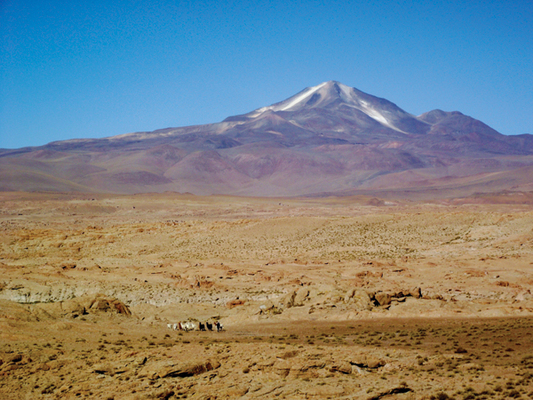
by Mary Caperton Morton Monday, January 23, 2012

Bolivia's Uturuncu volcano is the fastest-growing volcano on Earth. Shanaka de Silva
Supervolcanoes are one of nature’s most destructive forces, but given that there are no recorded observations of super-eruptions — the last occurred 74,000 years ago in Indonesia — scientists don’t fully understand how they work. Now a team studying the world’s fastest-inflating volcano, Bolivia’s Uturuncu, is shedding some light on how supervolcanoes become so powerful.
So far, most of what scientists know about supervolcanoes comes from studying the aftermaths of eruptions in places like Yellowstone National Park in Wyoming or Lake Toba in Indonesia.
“Most places we can only hope to reconstruct what happened after an eruption. At Uturuncu, we can observe in real time how the volcano is evolving,” says Noah Finnegan, a geomorphologist at the University of California at Santa Cruz. Finnegan is a member of the PLUTONS project, an international effort funded by the National Science Foundation to study Uturuncu, a 6,000-meter-tall stratovolcano in southern Bolivia. Uturuncu hasn’t erupted recently — the last eruption was about 300,000 years ago — but it’s far from dead.
Uturuncu isn’t a supervolcano, but it sits amid one of the largest collections of supervolcano calderas on Earth. This region — along the borders of Bolivia, Chile and Argentina, known as the Altiplano-Puna Volcanic Complex — is pockmarked by calderas from at least eight massive super-eruptions, the youngest dating to around 1 million years ago.
Uturuncu will not evolve into a supervolcano like its neighbors anytime soon, if ever, but Finnegan and colleagues say a lot can be learned by studying the volcano.
Since monitoring began in the 1980s, Uturuncu has held steady as the fastest-inflating volcano on Earth. On average, it grows by one centimeter a year, says Shanaka de Silva, a volcanologist at Oregon State University and a contributor to PLUTONS. That inflation is from magma being pumped into a belowground magma chamber. But unlike many volcanoes — where a rapidly inflating magma chamber often indicates an impending eruption — this one is remarkably stable and shows no signs of erupting any time soon.
“We’re trying to understand whether the rapid rate has something to do with the supervolcanic complex or if it’s just a rapidly moving normal volcanic system,” de Silva says. “Eventually, we’d like to have a better understanding of the rate at which magma is accumulating under Uturuncu and the geometry of that inflation,” he says.
The PLUTONS project has approached studying Uturuncu from so many angles, including InSAR satellite imagery, seismic and gravity data analysis, magnetotellurics, geomorphology and modeling studies, that de Silva says the effort seems more like volcanic forensics than mere geology.
“PLUTONS is bringing a lot of people from different areas of expertise together, which can produce interesting results,” says Ilya Bindeman, a volcanologist and geochemist at the University of Oregon who is not involved in PLUTONS.
Now in its third year, the project’s efforts are starting to show some rewards. Using a sophisticated modeling study, de Silva’s team has demonstrated a possible mechanism for accumulating massive volumes of magma without triggering an eruption, data they presented at the Geologic Society of America (GSA) annual meeting in Minneapolis, Minn., last October.
In most volcanoes, eruptions occur once the magma chamber has reached a certain capacity. Scientists have long speculated that supervolcanoes must have a means of expanding the magma chamber as it fills, thus accumulating more material without triggering an eruption.
The models suggest that a ductile layer of rock around the magma chamber could allow the pressure to build over tens of thousands of years, resulting in extensive uplifting in the roof above the magma chamber, enlarging the space and allowing a greater quantity of magma to collect over time without triggering an eruption.
“Most models take small historic eruptions and scale up the process to supervolcanic proportions,” de Silva says. The problem, he says, is that super-eruptions are not simply scaled-up normal eruptions.
Another study, led by Finnegan and also presented at the October GSA meeting, is using dried-up lakeshore deposits to study Uturuncu’s rate of inflation over the past few thousand years. “Currently the region around Uturuncu is very arid, but there were a lot of lakes here during the last glacial maximum,” Finnegan says. After slowly drying up over the past 10,000 years, the lakes left “bathtub rings” recording their former surface elevations.
“Lake surfaces tell us what was horizontal. Any tilting that has happened in the past few thousand years is an indicator of ground inflation, which allows us to extend the inflation record back much further,” he says. So far, Finnegan and colleagues have not found strong evidence that Uturuncu’s rapid rate of inflation has lasted for more than a thousand years, but what this means for the volcano’s future is unknown.
“If we can figure out what is going on underneath the volcano, we can try to understand what might happen in the future,” de Silva says. “Is this a mark of a developing supervolcano? Or just a rapidly inflating regular volcano?”
Despite Uturuncu’s inflation, there’s no immediate cause for alarm, de Silva says, as the volcano appears to be quite stable without any signs of a future eruption such as increased seismicity or gas emissions.
It’s unlikely anybody alive today will be around to see Uturuncu erupt, he says. “We’re dealing with time scales greater than human existence.”
© 2008-2021. All rights reserved. Any copying, redistribution or retransmission of any of the contents of this service without the expressed written permission of the American Geosciences Institute is expressly prohibited. Click here for all copyright requests.